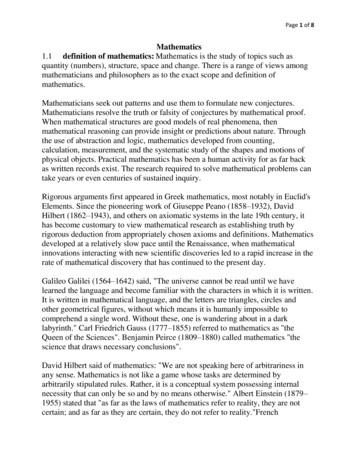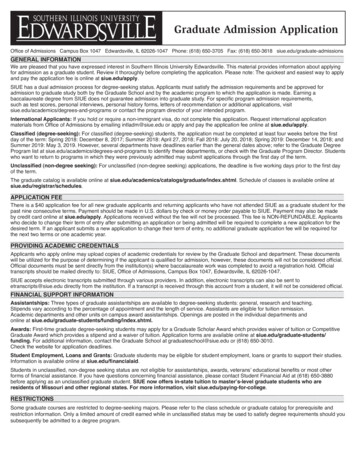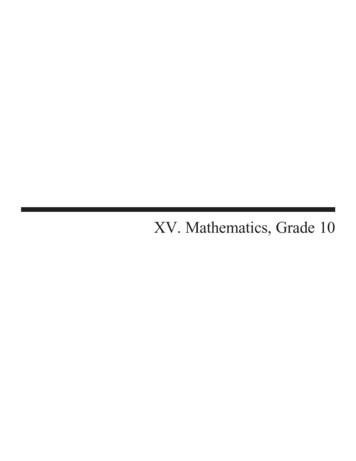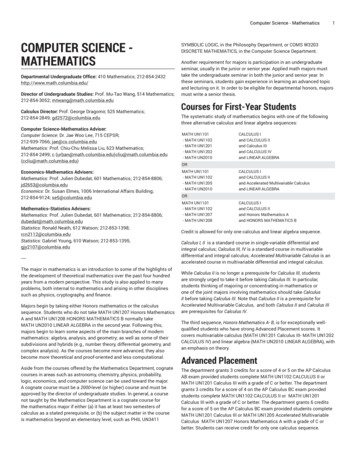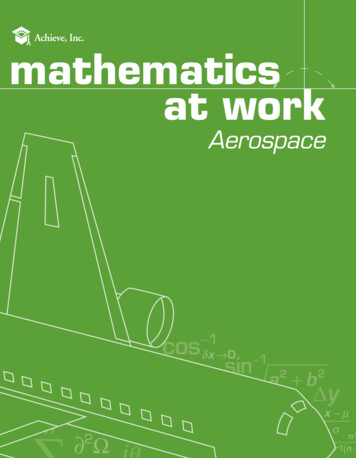
Transcription
mathematicsat workAerospace
Mathematics in the Aerospace SectorIt is projected that by 2016 there will be at least 500,000jobs in aerospace maintenance and manufacturing that paywell and offer opportunities for advancement. Accordingto the Bureau of Labor Statistics’ Occupational OutlookHandbook, technological advances in the industry requiremechanics to have an especially strong background inelectronics — and mathematics — to keep pace with thechanges in the industry. Additionally, many aerospace firmsrecently have begun to bring together teams composed ofcustomers, engineers and production workers to pool ideasand make decisions concerning aircraft design at everyphase of its development. The aerospace industry providesgood job opportunities for individuals with teamwork skillsand proficiency in technology and applied mathematics.Available Aerospace JobsWithin the aerospace industry, there are a variety of entrylevel jobs that pay well and provide opportunities foradvancement — jobs for high school graduates withpostsecondary training or education but less than a fouryear college degree. High school graduates with 18 to 24months of specialized postsecondary training leading to FAAcertification are qualified to become aircraft mechanics.JobsMedian yearlysalaryCore Mathematics Knowledgein Today’s Aerospace JobsDeveloped by secondary, postsecondary, business,industry and government leaders, the Career ClusterPathway Plan of Study for Maintenance, Installationand Repair was designed to serve as a guide forstudents’ educational and career goals. This Planof Study for individuals pursuing a career in aerospacerecommends a rigorous set of mathematics courses forstudents to take at both the secondary and postsecondarylevels in traditional or vocational settings. This Planof Study shows in detail how the foundation providedby courses such as Algebra I, Geometry, Algebra II,Trigonometry or Statistics, Physics, and ComputerApplications equips high school graduates with themathematical knowledge and skills needed for successon the job. Until high school graduates understand theadvanced mathematical skills used in the aerospacesector, they will remain unable to meet the demands ofthis high-growth industry. For more information on theCareer Clusters Initiative, see ntage of total jobs byeducation/training (ages 25–44)*Number of total jobsHigh schoolSome college20062016% changeAircraft mechanicsand service technicians 47,70033%57%122,500135,50011%Avionics technicians 46,90031%65%15,70017,0008%*Remaining percentage of workers in occupation have a bachelor’s degree or higherSource: Bureau of Labor Statistics, U.S. Department of Labor, Occupational Outlook Handbook, 2008–09 Edition.
Ensuring College and Career Readiness:The American Diploma ProjectIn 2001, Achieve and several partner organizationslaunched the American Diploma Project (ADP) toidentify a common core of English and mathematicsacademic knowledge and skills, sometimes referred toas “benchmarks,” that American high school graduatesneed for success in college and the workforce. TheseADP benchmarks, released in the 2004 report Ready orNot? Creating a High School Diploma That Counts, arethe result of two years of intensive research conductedin colleges and universities as well as workplaces acrossthe country.The real-world expectations identified by ADP are significantly more rigorous than many current high schoolgraduation standards — which helps explain why manyhigh school graduates arrive at college or the workplacewith major gaps in their English or mathematicspreparation.To help pinpoint the academic knowledge and skillsrequired for future employment, ADP commissionedleading economists to examine labor market projectionsfor the most promising occupations — those that payenough to support a family and provide real potentialfor career advancement. ADP then surveyed officialsfrom 22 industries, ranging from manufacturing tofinancial services, about the most useful skills fortheir employees to bring to the job.ADP also worked closely with two- and four-year postsecondary faculty from five partner states to determinethe prerequisite English and mathematics knowledge andskills required to succeed in entry-level, credit-bearinghigher education courses. These conversations revealedan unprecedented convergence of the knowledge andskills employers and postsecondary faculty say areneeded for new employees and freshmen beginningcredit-bearing coursework to be successful.“Mathematics at Work” SeriesFollowing up on the work of ADP, Achieve has produced a series of “Mathematics at Work” brochures toexamine how higher-level mathematics is used in today’s workplaces. The brochures present case studiesdrawn from leading industries nationwide to illustrate the advanced mathematics knowledge and skillsembedded in jobs that offer opportunities for advancement and are accessible to high school graduates.The series underscores the value of a rigorous high school curriculum in mathematics. All high schoolgraduates — regardless of whether they enroll in college, join the workforce or enter the military —benefit from acquiring a comprehensive knowledge base and skill set in mathematics.To view or download the ADP benchmarks, go to www.achieve.org/ADPbenchmarks. To view or downloada PDF of additional “Mathematics at Work” brochures, go to www.achieve.org/mathatwork.
Mathematics pilotsCareer Preparation for AircraftMaintenance Technicians“The more than 100,000 aircraft maintenance technicians(AMTs) at work in the public and private sector today havea wide range of talents and skills that keep America’sairplane fleet flying safely and smoothly. Although theymay have different educational backgrounds and areasof expertise, all AMTs have one thing in common — asolid foundation in mathematics, enabling them to earnrigorous Federal Aviation Administration (FAA) certificationin airframe and power plant maintenance. From fabricatingparts and installing hydraulic systems to testing electricalcircuits and repairing airplane engines, AMTs possess thehighly sought-after mechanical knowledge and skills —grounded in mathematics — that are valued by the airlineindustry.Without a strong math and sciencebackground, today’s technician isnot likely to progress far beyondbasic line maintenance.”La Vern Phillips, Regional DirectorAviation Institute of MaintenanceTo earn FAA certification, applicants must have at leasta high school diploma and 18–24 months of specializedpostsecondary training, be it on the job, at a communityor technical college, or in a specialty occupation in themilitary. Through a combination of oral and practicalexams, the FAA assesses the competency of applicantsin handling equipment such as ignition analyzers, rivetersand compression checkers. It also tests their familiaritywith scientific principles such as basic gas laws andthe properties of metals as well as the underlyingmathematical concepts that cover many core ADPbenchmarks. For example, the FAA requires that allAMTs understand:n Measurements with units when replacing andfabricating fuselage partsn Proportions and ratios when assessing the electricalneeds of circuitryn Solving equations with one or more variables whenrepairing hydraulic systemsn Calculating volume of spheres, parallelepipeds andcylinders when assessing fuel needsn Modeling with linear equations when computingthe center of gravity (CG) of an aircraftThe FAA certification process tests the understandingfuture AMTs have of the array of instruments andprocesses used on a daily basis, thereby evaluatingtheir ability to apply their mathematical skills to thevarious challenges they face. Given the vital stakesattached to aircraft safety, it also is critical that everyone on the tarmac — pilots, engineers and AMTs — isable to communicate with other members of the teamby speaking clearly about an airplane’s electronicsand mechanics through the universal language ofmathematics. Because no two aircraft are exactlythe same, AMTs must know when and how to applyparticular solutions to unique problems and modifyapproaches from aircraft to aircraft as appropriate.For more information on FAA aircraft maintenancecertifications, go to www.faa.gov/mechanics/become.
aviation safetySafety in Numbers: Mathematicsin Action on the TarmacAmerica’s future is up in the air — literally — and itis up to airframe and power plant technicians to keepAmerica flying safely. The image of a tire-kicking, greasecovered mechanic has long since been replaced by theprofessionalism of today’s FAA-certified AMT. Thesemathematically adept craftsmen ply their trade acrossevery facet of aviation.Repairing a Crack in the FuselageMathematical Reasoning andProblem SolvingDuring the standard preflight check, AMTs are responsible for inspecting the airplane for any suspicious signsof wear and tear. Faced with a crack in an airplane’sfuselage, a team of AMTs must first determine the mosteffective method of repair. To do this, AMTs dependon knowledge of the physical properties of metals andcomposites — their strength, flexibility anddurability — when put under the stressof flight. AMTs need to understand therelationship between the materials usedto construct the aircraft and the partsneeded to make the repair, and knowthe best methods for securing theseparts to the aircraft. Calculatingsheer strength also will help theAMT select the most appropriatematerials for mending thecrack — such asusing metal rivets,a compositemixture ofresin and hardener, or the fabrication of a new part. Ifa new part is required, the shape of the fabricated partis another important variable — especially if the crackhas appeared on a part of the airplane with significantcurvature. In that situation, AMTs have little choice butto create a new part to replace the damaged section.Fabricating New Parts for RepairGeometry, Algebra and TeamworkDepending on the size of the crack, the weightrestrictions and the bend allowance of the fabricatedmaterial, AMTs must perform a sophisticated seriesof algebraic and geometric calculations to determinethe amount of material needed for the replacementpart, the shape it should take, and the maximumweight allowance and other tolerances.For example, creating a patch for a particularly curvedsection of the airplane’s fuselage (or wing) requirescalculating the bend allowance of sheet metal — adimensional adjustment that must be factored in toensure the safety of the replacement part. When AMTsbend metal to the desired form, the material of theoutside angle is stretched, while the material on theinside angle is compressed. Determining the properbend radius is essential to constructing a strong andsound part. Too small a radius can cause further cracking,while too large a radius can result in costly overrunsof material, excess weight and ultimately a disruptionin the airplane’s CG. To properly calculate the bendallowance, AMTs must measure the length of thebrackets and the material thickness along with theangle and radius of the bend. They also must determine
Bendallowance Since ballast is useless weight and only wastes fuel,fabricating durable but lightweight replacement partsis key to minimizing the need for additional costlyadjustments to the airplane’s CG.Angle in degrees x (π/180) x(Radius K-factor x Thickness)the “neutral axis,” or the K-factor — the percent ofthe material thickness where there is no stretching orcompressing. Once the bend allowance is calculated,technicians can fabricate a new part; choose theappropriate rivet size, rivet pitch and tooling; andsuccessfully repair the aircraft.Moment j Weight j x DistancejCenter of gravity ( Moments) / Total weightKeeping Airplanes FlyingMaintaining Center of GravityMeasurement and ProportionsA team of AMTs working together also must consider theeffect the repair will have on the airplane’s CG. Becausean aircraft is designed to be balanced forward and aft,the CG is located in a precise range along the chordof the wing — the distance between the leading andtrailing edge of a wing. If the actual balance point is too farforward or too far aft, the pilot may experience difficultymaintaining level flight.When making adjustments to an airplane’s fuselage,AMTs must find the CG by weighing the aircraft withplatform scales or by using load cells positioned atdesignated points along the fuselage. AMTs mustcalculate these specific weights and the dimensionsof those points to determine “moments” along an axisand determine the range within which the CG can belocated. If, after making the repair, the actual CG fallsbeyond the approved envelope, the technicians needto calculate where and how much ballast they shouldadd to reposition the CG within the approved range.Keeping an aircraft ready for flight requires AMTs to makedozens of complex decisions every day as they inspect,repair and maintain a wide variety of aircraft. Ensuringan airplane’s airworthiness and the safety of the crewand passengers is not based on a wing and a prayer —it is grounded in a sophisticated understanding of howto apply the principles of algebra, trigonometry and evencalculus to airplane maintenance. Keeping America flyingsafe and sound is just another example of mathematicsat work today.“Whether it is manufacturing a newcomponent, repairing a damagedstructure, performing an aircraftweight and balance calculation, orperforming operational checks,mathematics is essential.”E. Wayne LeeHead Aircraft Services BranchNASA
Mathematics Teamwork SuccessAMTs must have a strong foundation of mathematicalknowledge and skills to successfully inspect, repair andmaintain the airworthiness of an airplane. AMTs needto tap into their problem-solving skills to diagnose anypotential issues that arise and make well-informeddecisions to resolve those problems quickly andefficiently.that both in the college classroom and in the workplace, professors and employers identify collaborationand communication as important factors for success.Since AMTs may have individualized training in particularsystems, such as engine repair, AMTs often work togetherand learn from each others’ expertise to ensure that everyairplane is in top-flight condition.When a team of AMTs identifies a crack in the fuselageof an airplane, for example, they must first hone in onthe best repair solution, using inductive and deductivereasoning. AMTs also use their knowledge of variousmaterials’ properties and sheer strength to determinethe appropriate materials and fabrication methods torepair a crack on a particular part of the aircraft.The required postsecondary training — be it in thefield or in the classroom — combined with the rigorousFAA certification test and the on-the-job instruction, allunderscore the need for future AMTs to leave high schoolhaving completed a rigorous set of courses aligned withcollege and career readiness expectations, especially inmathematics.“The technicians rely on many mathematics-based skillsto fabricate a new part, including using real and rationalnumbers, calculating ratios and proportions, and measuringplane figures. Computing the bend allowance requiresAMTs to use algebraic and geometric concepts to ensurethat the newly fabricated part fits just right.AMTs must monitor the consequences of their actions onthe airplane’s overall airworthiness and performance. Whenthe team of AMTs installs the new part, they may shift theairplane’s CG. If so, the AMTs will need to calculate a newCG, requiring the application of such mathematics skillsas converting units of measurement and solving equationswith one or more variables.Although fabricating a new part to repair a crack in anairplane relies on AMTs’ mathematical and technologicalknowledge, teamwork also is critical. ADP research showsMathematics plays a huge rolein the day-to-day activities ofaircraft mechanics. Consciouslyor subconsciously, mechanicsutilize their knowledge of math.The basic principles of algebra,trigonometry and even calculusare applied towards ensuring theairworthiness of the aircraft andthe safety of the crew.”E. Wayne LeeHead Aircraft Services BranchNASA
About AchieveAchieve, Inc., created by the nation’s governors and business leaders, is a bipartisan, non-profit organization thathelps states raise academic standards, improve assessments and strengthen accountability to prepare all youngpeople for postsecondary education, careers and citizenship.About the American Diploma Project (ADP) NetworkIn 2005, Achieve launched the ADP Network — a collaboration of states working together to improve their academicstandards and provide all students with a high school education that meets the needs of today’s workplaces anduniversities. The ADP Network members — responsible for educating 80 percent of all our nation’s public highschool students — are committed to taking four college and career readiness action steps:2. Require all students to complete a college- and career-ready curriculum to earn a high school diploma.3. Build college- and career-ready measures into statewide high school assessment systems.4. Hold high schools and postsecondary institutions accountable for student success.The world has changed, and high schools must change with it. The ADP Network is leading the charge inensuring that all high school students graduate with a degree that works.Visit our Web site for more information about the ADP Network and the ADP benchmarks (www.achieve.org/ADPbenchmarks) and to view additional “Mathematics at Work” brochures (www.achieve.org/mathatwork).Copyright April 2008 Achieve, Inc. All rights reserved.Achieve, Inc.n1775 Eye Street NW, Suite 410nWashington, DC 20006nwww.achieve.orgEditorial assistance and design: KSA-Plus Communications1. Align high school standards with the demands of college and careers.
Following up on the work of ADP, Achieve has produced a series of "Mathematics at Work" brochures to examine how higher-level mathematics is used in today's workplaces. The brochures present case studies . using metal rivets, a composite mixture of resin and hardener, or the fabrication of a new part. If


